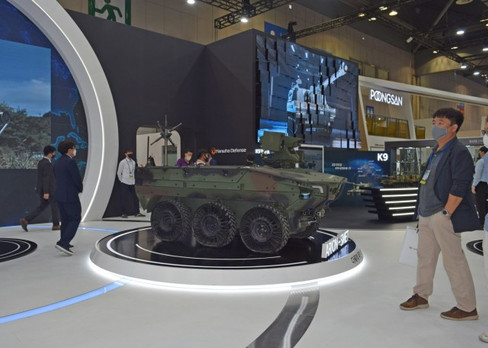In recent years, South Korea's arms exports have multiplied. In October 2022, South Korean Defense Minister Lee Jong-Sup stated that South Korea's arms exports had reached 13 billion U.S. dollars in the first nine months of this year, and the production-driven effect has reached 38 trillion won (about 28.81 billion U.S. dollars), which is four times of the average annual export volume in 2020.
New weapons at the DX Korea 2022
On September 21, the opening ceremony of the "Korea Defense Expo 2022" (DX KOREA 2022) was held at the Korea International Exhibition Center (KINTEX) in Goyang, Gyeonggi-do. All major Korean military enterprises participated in the expo, and military personnel from more than 50 countries, including the United States, Slovakia, Romania, and Pakistan, participated in related activities.
At the DX KOREA 2022, South Korean military enterprises focused on displaying new weapons equipped with artificial intelligence, robots, and stealth functions, and unmanned weapons were also eye-catching.
Hanwha Group mainly exhibits next-generation weapons that combine artificial intelligence, lasers, and unmanned technologies. Hanwha Defense displayed unmanned intelligent vehicles based on artificial intelligence technologies, such as driverless vehicles, and a three-dimensional phase array multifunctional radar that can detect and track targets and guide missiles in all directions. At the same time, Hanwha Group's drone detection and firepower system using laser technology have also received more attention.
The Korean Aerospace Industries Corporation (KAI) disclosed the KF-21N, a small multi-purpose helicopter, multi-purpose transport aircraft, and carrier-based aircraft for special operations. The small gunships expected to enter combat in 2023 carry air-to-surface missiles that can neutralize enemy tanks at ranges of several kilometers. The company said that to enhance global competitiveness; in addition to hardware production, it will also strive to improve the quality of high-value-added services such as software design.
LIG NEX1 highlights the guided weapons on board the drone. This small UAV can use the laser to designate targets and carry out precise strikes. LIG also demonstrated electronic warfare equipment for ships and drones carrying 40 kilograms.
Kia, Hyundai Wia, and Hyundai Rotem under the Hyundai Motor Group mainly displayed ground military equipment. For the first time, Hyundai Wia launched the "anti-drone system" that uses artificial intelligence technology to defend against drone attacks. Hyundai Rotem introduced K2 tanks and armored vehicles equipped with 105mm guns, which were exported to Poland and Norway. Kia has revealed various hydrogen-powered military vehicles, such as a medium-sized concept truck using hydrogen fuel cells.
Stepping up to develop overseas markets
South Korea actively promotes the construction and development of the military industry, adopting a method led by national scientific research institutions and participating by private enterprises.
In August 1970, South Korea established the first specialized military industry science and trade organization, the Agency for Defense Development (ADD). It passed legislation to encourage private companies to invest in the military industry.
Large companies such as Hyundai, Samsung, LG, and Hanwha are all involved in the military industry. For example, South Korea's K-2 main battle tank is the product of the cooperation between Hyundai and Samsung. The K-9 self-propelled artillery is the most typical result of the collaboration between the Hanwha Group and ADD.
The South Korean government has invested heavily in formulating policies and laws and realizing the industrialization of the military industry, gradually forming a comparative advantage in large-scale production. In 2020, the South Korean government released the "Core Technology Plan for 2020-2034", providing a strategic direction for developing core technologies required by advanced military systems.
Currently, South Korea's military sales targets are traditional weapons such as land combat armor, which reduces product development costs and cycles. High operating rates, low prices, and operating and maintenance costs are the most significant advantages of South Korea's military industry exports.

On October 19, 2022, the South Korean military enterprise "Hyundai Rotem" held a delivery ceremony for the first K-2 tanks exported to Poland at the Changwon factory. On the same day, "Hanwha Defense" under the Hanwha Group held a delivery ceremony for the first batch of K-9 self-propelled artillery exported to Poland at the Changwon factory.
From the perspective of the industrial system, South Korea already has the world's advanced level in many fields such as steel, petroleum, chemical industry, automobile, machinery, ship, semiconductor, and smartphone. This vast and sound industrial system has laid a good foundation for developing South Korea's military industry. With the support of the domestic industrial system, South Korea's military industry has a solid ability to integrate. It is good at reducing the R&D cost of its products by purchasing mature subsystem technologies from the West.
For example, South Korea’s KF-21 fighter jet, which has been introduced to the international arms market, consulted with Lockheed Martin during the design stage and integrated the F-414-GE400K engine of General Electric Company. The avionics system was controlled by Jointly developed by Hanwha Systems and Israel Elbit; the ejection seat directly purchases mature products from Martin Baker in the UK. These mature sub-system technologies can not only effectively reduce product R&D costs but also reduce product R&D cycles and rely on cost performance to create their market.
Compared with traditional arms exporting countries such as the United States, Germany, and France, South Korea's military products are not far behind in terms of performance, but the price is relatively low, which is quite attractive to countries with weak arms purchasing power.
In addition, South Korea's special alliance with the United States and its defense ties with NATO have also reduced restrictions on its arms exports by countries such as the United States and Europe.
The severe and complex international situation promotes the development of South Korea's military industry.
Changes in the international situation and environment in recent years are also conducive to South Korea's military industry development. With the increase of armaments around the world, South Korea has made full use of the competitiveness of the military industry accumulated over the years to promote arms exports rapidly.
According to a survey by the Stockholm International Peace Research Institute (SIPRI) in Sweden, the global defense budget in 2021 will reach 2.1 trillion US dollars, the first time in history to exceed 2 trillion US dollars.
After the Ukrainian crisis escalated in 2022, some European countries such as Germany, Finland, Sweden, and Poland rapidly increased their defense budgets, thereby gradually spreading the "domino" trend of increasing armaments worldwide.
The US$839 billion 2023 defense budget, the largest in U.S. history, has been passed by the House of Commons. The Japanese government has also stated that it will increase defense spending to 2% of the gross domestic product (GDP) within the next five years.
With the protracted trend of the Ukraine crisis, major arms-exporting countries such as the United States, France, Germany, and the UK are busy supporting arms to Ukraine and have little spare capacity to meet the needs and delivery time requirements of other arms-buying countries. South Korea has actively promoted arms exports by taking advantage of the space left by major Western arms exporters.
In addition, South Korea's military industry attaches great importance to giving full play to its marketing advantages to forming a more effective marketing system. On the one hand, conduct careful research and formulate marketing and cooperation plans according to the needs of potential customers, including joint production with local companies or providing financial support. For example, Korea establishing the K-9 self-propelled howitzer production line in Turkey helped Korean weapons successfully enter the NATO market.
On the other hand, focus on adopting the "group" sales model. On occasions such as presidential visits and international air shows, South Korea usually sends a large military industry team led by senior government officials to give full play to the advantages of large-scale military industry "group" propaganda.
South Korea's goal: "Global top four arms exporters"
In August 2022, in his 100-day commemorative speech, President Yoon Suk-yeol stated that the military industry should be supported as a "pillar industry" in South Korea, and South Korea should be built into a "strategic industrialization and defense industrialization powerhouse" and become the world's fourth largest arms exporter.
South Korea is an important country in global arms exports and a significant arms importer. Its arms imports rank sixth in the world. It mainly imports aircraft, missiles, and air defense systems from the United States, Germany, and France.
Although the development goals are ambitious, South Korea needs to improve to become a world-class arms power.
From the perspective of product competitiveness, South Korea's export equipment is relatively single, with narrow sales channels. Its core technology still relies on Western countries such as the United States, Germany, Britain, and Israel.
Some buyers who are allies of the United States said that the South Korean FA-50 fighter jets are only their replacements and that in the future, they will mainly introduce fighter jets jointly developed by Europe and American-made F-35 fighter jets. In fact, except for the United Arab Emirates and Saudi Arabia, most countries' introduction of South Korean weapons is more of an expedient measure.
However, South Korea is already a world leader in electronic semiconductors and has a solid technical accumulation in precision-guided missiles and other fields. In the future, there is a lot of room for developing the military industry for South Korea.
Disclaimer: All the information on this website is provided on an “as is” and “as available” basis, and you agree to use such information entirely at your own risk. Monisight gives no warranty and accepts no responsibility or liability for the accuracy or completeness of the information and materials contained in this website.
Under no circumstances will Monisight be held responsible or liable in any way for any claims, damages, losses, expenses, costs, or liabilities whatsoever (including, without limitation, any direct or indirect damages for loss of profits, business interruption, or loss of information) resulting or arising directly or indirectly from your use of or inability to use this website or any websites linked to it, or from your reliance on the information and material on this website, even if the Monisight has been advised of the possibility of such damages in advance.









Comments